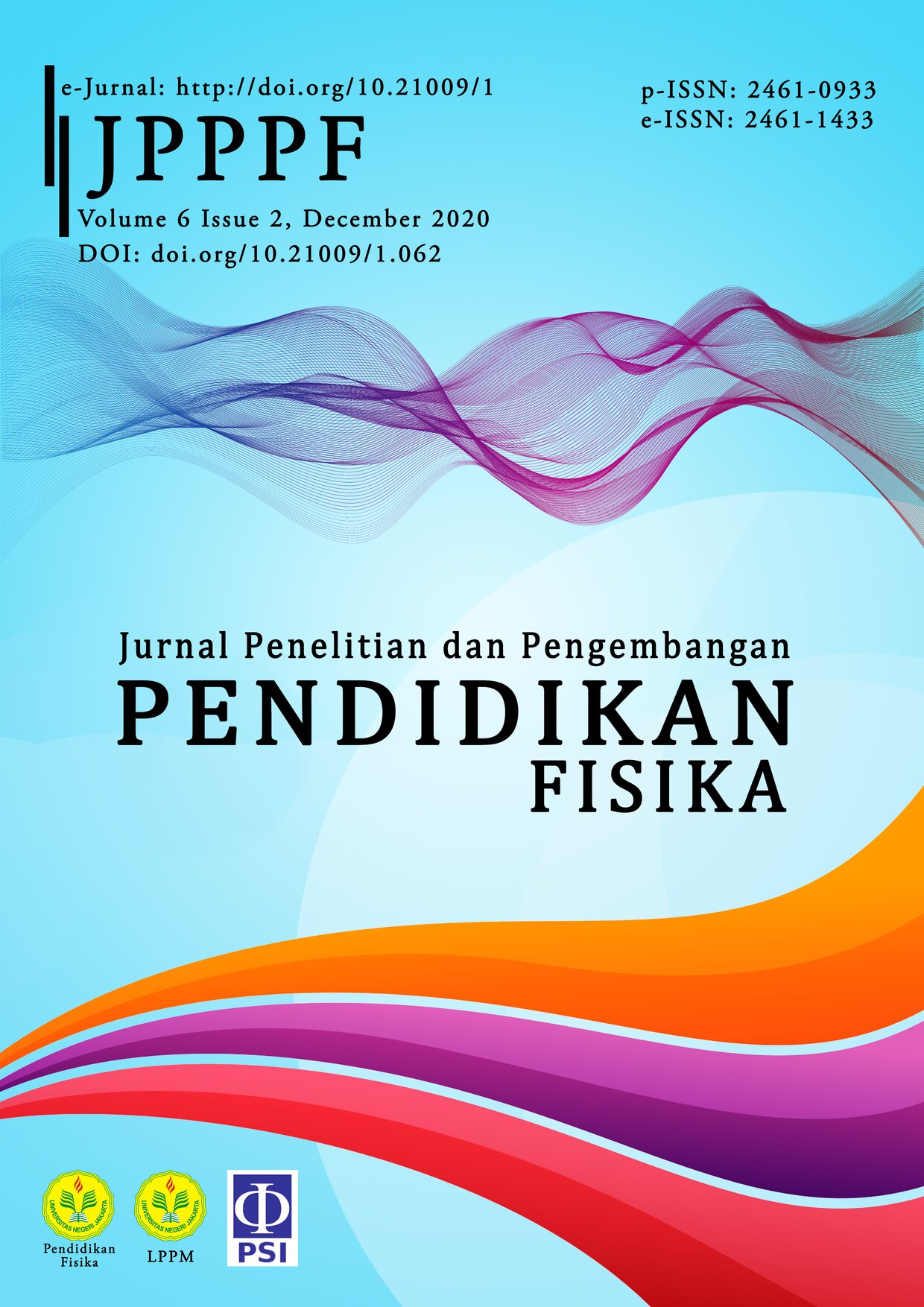Physics Online Learning Devices Based on Guided Discovery Model for High School Class X on Momentum and Impulse Material
DOI:
https://doi.org/10.21009/1.06203Keywords:
online learning tools, guided discovery, momentum dan impulseAbstract
This development research aims to develop online physics learning tools based on guided discovery models for high school grade X students with momentum and impulse material and test the feasibility of Physics online learning tools through validator assessments (material experts, material experts) and limited trials by students' responses. Physics online learning tools developed in the syllabus, lesson plans, student worksheets, handouts, and learning media. The average score of validation assessment for the syllabus is 4.81, the lesson plan is 4.72, the student worksheet is 4.64, the handout is 4.57, the media is 4.76, and the media material is 4.66. All in categorized as very worthy. In this study, a limited trial was conducted for 27 students divided into three groups. The average score results student on worksheet one is 4.06, worksheet two is 3.98, and worksheet three is 3.87. All in with categories worthy. The average score result of handout one is 4.04, handout two is 3.96, and handout three is 4.01. All in with worthy category. The results obtained from the Physics online learning tool based on guided discovery models are appropriate for online learning on momentum and impulse material for grade X high school students.
References
Arikunto, S 2013, ‘Validitas dalam Dasar-Dasar Evaluasi Pendidikan’, Jakarta: Bumi Aksara.
Bakri, F, Sunaryo, Irawan, VF, & Muliyati D 2018, ‘E-Learning Model for Problem Based Learning onHeatand Thermodynamic Topicsin High School’, Jurnal Penelitian dan Pengembangan Pendidikan Fisika (JPPPF), vol. 4, no.2, pp. 101-112.
Cavus, N & Alhih, MS 2014, ‘Learning Management Systems Use in Science Education’, Procedia - Social and Behavioral Sciences, vol. 143, February 2014, pp. 517-20.
Data Statistik Kemendibud 2018, ‘Laporan Jumlah Siswa SMP Dan SMA Di Indonesia Tahun 2018’, Jakarta.
Denny, YR, Utami, IS, Rohanah, S, Muliyati, D 2020, ‘The Development of Blended Learning Model using Edmodo to Train Student Critical Thinking Skills on Impulse-Momentum Topic’, Jurnal Penelitian dan Pengembangan Pendidikan Fisika (JPPPF), vol. 6, no.1, pp. 113-20.
Departemen Pendidikan Nasional 2008, ‘Pengembangan Bahan Ajar dan Media’, Jakarta: Departemen Pendidikan Nasional.
Eveline, E, Suparno, Ardiyanti, TK, Dasilva, BE 2019, ‘Development of Interactive Physics Mobile Learning Media for Enhancing Student's HOTS in Impulse and Momentum with Scaffolding Learning Approach’, Jurnal Penelitian dan Pengembagan Pendidikan Fisika (JPPPF), vol. 5. no. 2, pp. 123-32.
Habibbulloh, M, Jatmiko & Widodo, W 2017, ‘Pengembangan Perangkat Pembekajaran Model Guided Discovery Berbasis Lab Virtual Untuk Mereduksi Miskonsepsi Siswa SMK Topik Efek Fotolistrik’, Jurnal Penelitian FIsika Dan Aplikasinya (JPFA), vol. 07, no. 01, pp. 27-43.
Krouska, A, Troussas,C, &Virvou M 2017, ‘Comparing LMS and CMS Platforms Supporting Social e-Learning in Higher Education’, Conference: 2017 8th International Conference on Information, Intelligence, Systems & Applications (IISA), pp. 1-6.
Liu, TC 2007, ‘Teaching in a Wireless Learning Environment: A Case Study’, Educational Technology and Society, vol. 10, no. 1, pp. 107-23.
Malik, A, Vitriani & Chusni, MM 2018, ‘Improving Students' Critical-Thinking Skills Through Student Facilitator and Explaining Model in Momentum and Impuls Topic’, Jurnal Penelitian dan Pengembangan Pendidikan Fisika (JPPPF), vol. 4, no. 2, pp. 55-64.
Martin, A & Madigan, D 2006, ‘Digital Literacies for Learning’, London: Facet Publishing.
Putri, RF & Jumadi, J 2017, ‘Kemampuan guru fisika dalam menerapkan model-model pembelajaran pada kuriulum 2013 serta kendala-kendala yang dihadapi’, Jurnal Inovasi Pendidikan IPA, vol. 3, no. 2, pp. 201-11.
Qomariyah, S, Gunarhadi & Rejekiningsih, T 2018, ‘Edmodo in Blended Learning to Increase Language Learners’ Understanding in Learning Grammar for Toef’, International Journal of Educational Research Review, vol. 4, no. 1, pp. 82-7.
Rahmi, Ulfia, Jasrial, J, Ansyar, M & Effendi, ZM 2018, ‘The Development of Message-Design Model in Blended Learning’, The Asian Journal of Technology Management (AJTM). Vol. 10, no.1, pp. 1-9.
Rezeki, S & Ishafit 2017, ‘Pengembangan Media Pembelajaran Interaktif untuk Sekolah Menengah Atas Kelas XI pada Pokok Bahasan Momentum’, Jurnal Penelitian dan Pengembangan Pendidikan Fisika (JPPPF), vol. 3, no.1, pp. 29-34.
Suprihatiningrum, J 2013, ‘Strategi Pembelajaran Teori dan Aplikasi’, AR-Ruzz Media. Yogyakarta.
Susilo, PH, Rohman, MG 2019, ‘Sistem Pembelajaran Online Berbasis Aplikasi Web Menggunakan Framework Codeigniter’, JOUTICA, vol. 4, no. 2, pp. 281-86.
Thiagarajan, S, Semmel, DS, and Semeel, MI 1974, ‘Instructional Development for Training Teachers of Exceptional Children: A Sourcebook’, Journal of School Psychology, vol. 14, no. 1, p. 75.
Trinder, R 2015, ‘Blending Technology and Face-to-Face: Advanced Students’ Choices’, ReCALL, vol. 28, no. 1, pp. 83-102.
Usman, S 2018, ‘Sekolah Masa Depan Di Era Digital Belajar Dan Mengajar Di Mana Saja’, The Conversation.
Widoyoko, S & Eko, P 2011, ‘Evaluasi program pembelajaran’, Yogyakarta: Pustaka Pelajar.
Wijayanti, W, Maharta N & Suana W 2017, ‘Pengembangan Perangkat Blended Learning Berbasis Learning Management System Pada Materi Listrik Dinamis’, Jurnal Ilmiah Pendidikan Fisika Al-Biruni, vol. 6, no. 1, p. 1.
Yusnia, D & Suparman 2018, ‘Analisis Kebutuhan Bahan Ajar Berbasis Guided Discovery’, Prosiding Seminar Nasional Etnomatnesia, pp. 395-99.











